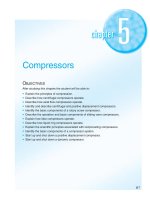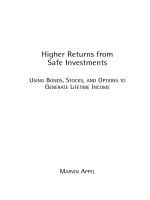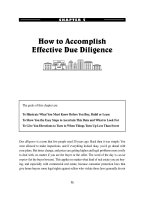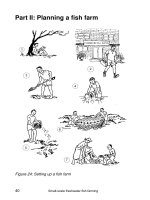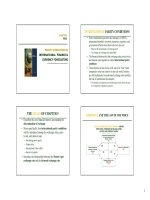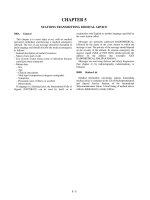Lecture Radio Communication Circuits: Chapter 5&6 - Đỗ Hồng Tuấn
Bạn đang xem bản rút gọn của tài liệu. Xem và tải ngay bản đầy đủ của tài liệu tại đây (1.49 MB, 65 trang )
Chapter 5:
IF Amplifiers and Filters
Dept. of Telecomm. Eng.
Faculty of EEE
1
CSD2012
DHT, HCMUT
References
[1] J. J. Carr, RF Components and Circuits, Newnes, 2002.
Dept. of Telecomm. Eng.
Faculty of EEE
2
CSD2012
DHT, HCMUT
IF Amplifier and Filters
Example:
Dept. of Telecomm. Eng.
Faculty of EEE
3
CSD2012
DHT, HCMUT
IF Filters: General Filter Theory
The bandwidth of the filter is the bandwidth between the –3 dB points.
The Q of the filter is the ratio of centre frequency to bandwidth, or:
The shape factor of the filter is defined as the ratio of the –60 dB
bandwidth to the –6 dB bandwidth. This is an indication of how well the
filter will reject out of band interference. The lower the shape factor the
better (shape factors of 1.2:1 are achievable).
Dept. of Telecomm. Eng.
Faculty of EEE
4
CSD2012
DHT, HCMUT
L–C IF Filters
The basic type of filter, and once the most common, is the L–C filter,
which comes in various types:
Dept. of Telecomm. Eng.
Faculty of EEE
5
CSD2012
DHT, HCMUT
Crystal Filters (1)
The quartz piezoelectric crystal resonator is ideal for IF filtering
because it offers high Q (narrow bandwidth) and behaves as an L–C
circuit. Because of this feature, it can be used for high quality receiver
design as well as single sideband (SSB) transmitters (filter type).
Dept. of Telecomm. Eng.
Faculty of EEE
6
CSD2012
DHT, HCMUT
Crystal Filters (2)
Crystal phasing filter: a simple crystal filter, the figure shows the
attenuation graph for this filter. There is a ‘crystal phasing’ capacitor,
adjustable from the front panel, that cancels the parallel capacitance. This
cancels the parallel resonance, leaving the series resonance of the crystal.
Dept. of Telecomm. Eng.
Faculty of EEE
7
CSD2012
DHT, HCMUT
Crystal Filters (3)
Half-lattice crystal filter: Instead of the phasing capacitor there is a
second crystal in the circuit. They have overlapping parallel and series
resonance points such that the parallel resonance of crystal no. 1 is the
same as the series resonance of crystal no. 2.
Dept. of Telecomm. Eng.
Faculty of EEE
8
CSD2012
DHT, HCMUT
Crystal Filters (4)
Cascade half-lattice filter: The cascade half-lattice filter has increased
skirt selectivity and fewer spurious responses compared with the same
pass band in the half-lattice type of filter.
Dept. of Telecomm. Eng.
Faculty of EEE
9
CSD2012
DHT, HCMUT
Crystal Filters (5)
Full lattice crystal filter uses four crystals like the cascade half-lattice,
but the circuit is built on a different basis than the latter type. It uses two
tuned transformers (T1 and T2), with the two pairs of crystals that are
cross-connected across the tuned sections of the transformers. Crystals
Y1 and Y3 are of one frequency, while Y2 and Y4 are the other
frequency in the pair.
Dept. of Telecomm. Eng.
Faculty of EEE
10
CSD2012
DHT, HCMUT
Crystal Filters (6)
Crystal ladder filters: crystal ladder filter. This filter has several
advantages over the other types:
All crystals are the same frequency (no matching is required).
Filters may be constructed using an odd or even number of crystal.
Spurious responses are not harmful (especially for filters over four
or more sections).
Insertion loss is very low.
Dept. of Telecomm. Eng.
Faculty of EEE
11
CSD2012
DHT, HCMUT
IF Amplifiers (1)
A simple IF amplifier is shown in below figure:
Dept. of Telecomm. Eng.
Faculty of EEE
12
CSD2012
DHT, HCMUT
IF Amplifiers (2)
The IF amplifier in below is based on the popular MC-1350P:
Dept. of Telecomm. Eng.
Faculty of EEE
13
CSD2012
DHT, HCMUT
IF Amplifiers (3)
More IF amplifier ICs (MC-1590, SL560C):
Dept. of Telecomm. Eng.
Faculty of EEE
14
CSD2012
DHT, HCMUT
IF Amplifiers (4)
Dept. of Telecomm. Eng.
Faculty of EEE
15
CSD2012
DHT, HCMUT
Chapter 6:
RF Oscillator and
Frequency Synthesizer
Dept. of Telecomm. Eng.
Faculty of EEE
CSD2012
DHT, HCMUT
References
[1] J. Rogers, C. Plett, Radio Frequency Integrated Circuit Design,
Artech House, 2003.
[2] W. A. Davis, K. Agarwal, Radio Frequency Circuit Design, John
Wiley & Sons, 2001.
[3] F. Ellinger, RF Integrated Circuits and Technologies, Springer
Verlag, 2008.
[4] U. L. Rohde, D. P. Newkirk, RF/Microwave Circuit Design for
Wireless Applications, John Wiley & Sons, 2000.
Dept. of Telecomm. Eng.
Faculty of EEE
17
CSD2012
DHT, HCMUT
Oscillator Fundamentals (1)
An oscillator is a circuit that converts energy from a power source
(usually a DC power source) to AC energy (periodic output signal). In
order to produce a self-sustaining oscillation, there necessarily must be
feedback from the output to the input, sufficient gain (amplifier) to
overcome losses in the feedback path, and a resonator (filter).
The block diagram of an oscillator with positive feedback is shown
below. It contains an amplifier with frequency-dependent forward gain
a(ω) and a frequency-dependent feedback network β(ω).
Dept. of Telecomm. Eng.
Faculty of EEE
18
CSD2012
DHT, HCMUT
Oscillator Fundamentals (2)
The output voltage is given by:
It gives the closed loop gain as:
For an oscillator, the output Vo is nonzero even if the input signal Vi is zero.
This can only possible if the closed loop gain A is infinity. It means:
This is called the Barkhausen criterion for oscillation and is often described
in terms of its magnitude and phase separately. Hence oscillation can occur
when
Dept. of Telecomm. Eng.
Faculty of EEE
19
CSD2012
DHT, HCMUT
Oscillator Fundamentals (3)
Osillator type: (DC and bias circuit not shown)
Dept. of Telecomm. Eng.
Faculty of EEE
20
CSD2012
DHT, HCMUT
Oscillator Fundamentals (4)
Dept. of Telecomm. Eng.
Faculty of EEE
21
CSD2012
DHT, HCMUT
Oscillator Fundamentals (5)
Dept. of Telecomm. Eng.
Faculty of EEE
22
CSD2012
DHT, HCMUT
Oscillator Fundamentals (6)
Example: This example illustrates the design method. The transistor is in
CB configuration, then there is no phase inversion for the amplifier.
The circuit analysis can be simplified with the assumption:
R h
1
RE hib = E ib
ω C2
RE + hib
It is also assumed that the quality factor of load impedance is high. Then,
the circuit reduces to:
Dept. of Telecomm. Eng.
Faculty of EEE
23
CSD2012
DHT, HCMUT
Oscillator Fundamentals (7)
where
and
The forward gain:
and the feedback transfer function:
Dept. of Telecomm. Eng.
Faculty of EEE
24
CSD2012
DHT, HCMUT
Oscillator Fundamentals (8)
where
According to Barkhausen criterion for phase:
and in this example β does not depend on frequency, then the phase shift
of or ZL must be 360o (or 0o). This only occurs at the resonant frequency
of the circuit:
At this frequency:
Dept. of Telecomm. Eng.
Faculty of EEE
25
CSD2012
DHT, HCMUT
